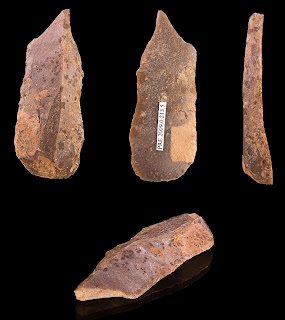A lot of the tools and technics used in the European Stone Age were similarly found in other cultures around the world - handdrill fire making, darts & atlatl, blade cores. One of the unique innovations of the Aurignacian culture (28,000 - 21,000 BP) was a specialized tool called the burin. They had refined striking blades off of a specially prepared stone cores, to modify into other tool forms - end scrapers, backed knives, perforators, shaft scrapers, and burins. A burin was a flint blade broken at an angle and beveled into a chisel-like tool. This was used to carve antler, wood, and bone. Archaeologists say this invention helped to create a whole new series of bone and antler tools. Some of the earliest carvings of bone and ivory were made at this time. The burin was used to score deep parallel grooves in lengths of antler and bone to isolate slivers that were pried out and worked into needles and spear points. This burin was made by snapping a blade at an angle, then a quick stroke with a hammerstone leaves a sharp beveled chisel edge. Lower left, is a burin from the Upper Paleolithic. Low right, blade core.
Subscribe to:
Post Comments (Atom)








No comments:
Post a Comment